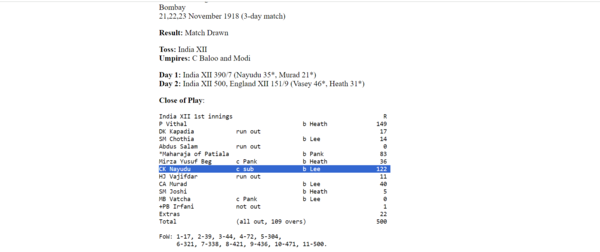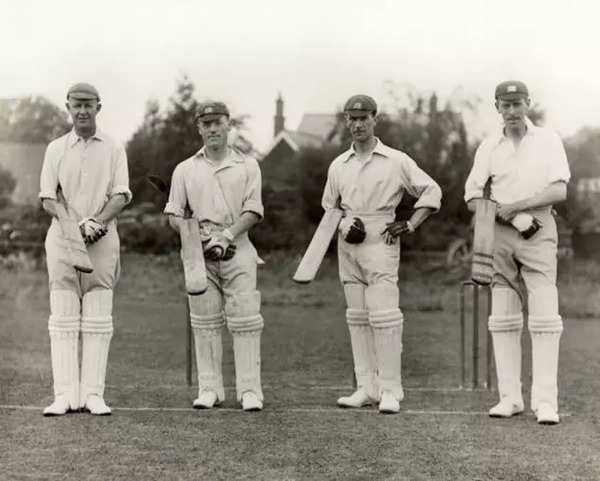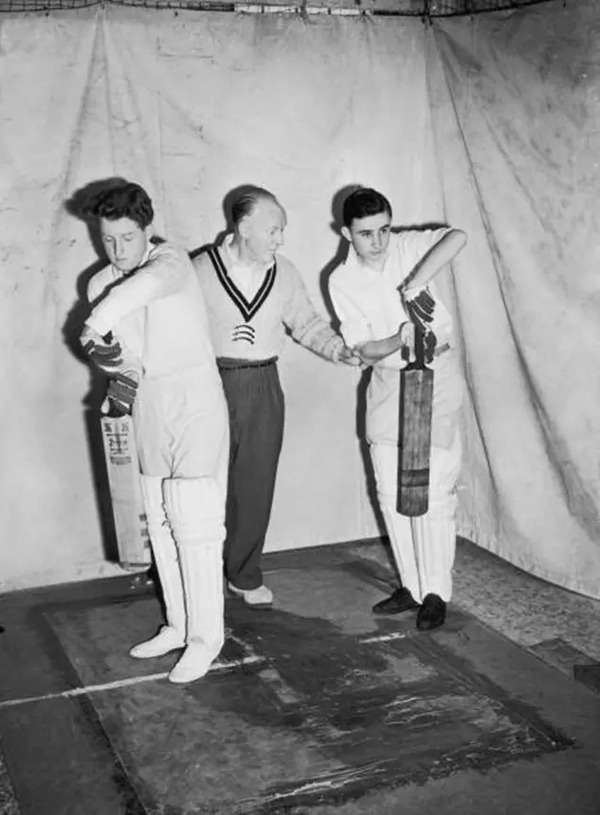However, have you ever ever heard of a cricketer who performed a Check match 15 years after his “demise”? Chances are high that you have not.
The yr was 1915. World Conflict I, or The Nice Conflict, was taking an enormous toll on Europe. Nice Britain had already been raided and bombed by Zeppelins (because the German airships had been recognized), in January 1915. German troops had captured Warsaw from the Russians. Tons of and hundreds of individuals had been dying day-after-day, together with many cricketers, and Europe was devastated. Wisden Almanack’s obituary part in 1915 crammed 77 pages, the record included names of two greats of the sport — W G Grace and Victor Trumper — though they did not die within the struggle.
Not within the army providers, Harry Lee was busy together with his cricket when the struggle broke out. In actual fact, his maiden century for Middlesex got here simply days after the struggle started, towards Nottinghamshire in August 1914, as he scored 139 runs at Lord’s Cricket Floor.
Born on October 26, 1890, Harry Lee was the eldest among the many ‘Lees of Marylebone,’ as three cricket-playing brothers had been recognized. Initially, he labored together with his father as a greengrocer however later determined to pursue a distinct path. On the age of 15, he wrote to the MCC in search of a job on the bottom workers at Lord’s Cricket Floor. After three years, he earned a spot within the Middlesex Colts (U9 – U18), and after two extra years, he made it onto the primary workforce in 1911. Though, he wasn’t an everyday fixture for Middlesex till 1914.
After the struggle broke out in August 1914, Britain requested its younger male residents to voluntarily be a part of the military. “It is much better to face the bullets than to be killed at house by a bomb, be a part of the military directly, and assist to cease an air raid. God save the King,” learn a poster issued by the UK authorities. Virtually 7.5 lakh residents joined the British Military, simply inside eight weeks after the struggle started. When British Territorial Forces marched via London, Lee, who was initially reluctant to hitch the struggle effort, determined to hitch the Military in September 1914.

Harry Lee was initially enlisted into the thirteenth Battalion, a part of the London regiment. The battalion was normally often called “The Kensingstons”, because it recruited a big variety of personnel from that space of London. After going via coaching for just a few months, Lee, on February 25, 1915, was posted to the 1/thirteenth Battalion, which consisted of males who had volunteered for abroad service. Simply over every week later, Lee was in France the place he took half within the Battle of Neuve-Chapelle (10–13 March 1915). The Battle was an Allied offensive, aimed to regain the French village of Neuve-Chapelle from German forces, and so they had been profitable of their effort.
Predicting one other assault, the Germans ready nicely and fortified the realm. The Battle of Aubers Ridge started on Might 9, and Kensingtons had been a type of to guide the assault from the northern pincer. The British Military efficiently struck some preliminary blows, however they got here at a really heavy value because the variety of casualties crossed 11,000 on the very first day.
Of the 550 Kensington males concerned within the battle, 499 misplaced their lives. Harry Lee was one in all them, it was presumed. After his physique was not discovered, the information about his demise unfold and reached his family. Lee’s mother and father held his memorial after his demise was introduced.
However Lee, fairly miraculously, was alive. The information of his demise was not true. “I’m glad to say this was untimely,” Lee later wrote in his autobiography. Though he was shot in his left thigh in the course of the battle and the bullet fractured his femur or thigh bone, he did not die. He lay in no man’s land, unconsciously, for 3 days, earlier than German forces discovered and transported him to a hospital in Valenciennes, France. The ten-hour journey, earlier than he was shifted to a French Purple Cross practice in Lille, was horrible. Lee was put right into a cattle practice with different wounded troopers, lay on sacks of straw, and supplied with a single bucket for use as a typical bathroom for all.
Lee had stayed at Valenciennes for nearly six weeks earlier than he was transferred to Hannover, Germany, and was handed over to the German Purple Cross. At Hannover, Lee’s wounds had been therapeutic however he, on the recommendation of a fellow struggle prisoner, determined to magnify his damage and requested for permission to return house. Permission was granted and Harry Lee started his journey to England on October 1, 1915.
Lee will need to have been rejoiced by the prospect of going again house and being reunited together with his household, however sorrow adopted him. When he was receiving remedy in England, docs advised him that he had suffered appreciable muscle demise, and his one leg can be completely shorter than the opposite one.
Harry was discharged from the Military in December 1915, and was honoured with the British Conflict Medal, 1914-15 Star, Silver Conflict Badge, and Victory Medal.
As he was discharged, docs advised him that he might neither be a part of the Military nor play cricket.
Life after ‘demise’ and Lee’s ‘tour to India’
After he was discharged from the Military hospital, Middlesex took care of him, and Lee was supplied with a specialist for the remedy. Out of the Military, Lee labored as a submitting clerk within the Conflict workplace.
However what about cricket? Nicely, he performed it once more. What else are you able to count on from a person who was firm sufficient to defy demise? Will not he play the sport that was so near his coronary heart? In early 1916 he performed a match for Royal Military Service Corps and scored a century towards Lancing Faculty, and performed some extra matches for the MCC right here and there.
By the tip of summer time of 1916, Harry Lee was prompt by the spouse of Frank Tarrant, his Middlesex colleague who had received the job in India, to accompany Tarrant in Calcutta.
Frank Tarrant was an Australian-English cricketer who later served as a cricket aide to the Maharajas of Patiala and Cooch Behar. “A canny adviser and an astute lobbyist with impeccable connections, Tarrant helped lay the foundations of Indian cricket,” writes Mike Coward in Tarrant’s biography ‘Cricket’s Forgotten Pioneer: The Frank Tarrant Story‘. Tarrant additionally holds the document for the primary man to take all ten wickets in an innings in a first-class match in India.
So Harry Lee accepted the provide of Tarrant’s spouse however it might take yet one more yr for Lee to embark on his journey to India as he misplaced his mom. A yr later, he determined to come back to India. Initially, he was to board Nyanza to Bombay. However, on the final minute, he was transferred to Nagoya which was immediately heading to Calcutta. It turned out that Lee had dodged demise but once more as Nyanza was torpedoed about 20 miles after it set sail and 49 lives had been misplaced.
In India, Lee labored as soccer and cricket coach to the Maharaja of Cooch Behar. “No matter you do, don’t get the Maharajah out for a duck. He doesn’t prefer it,” Lee would later write in his autobiography referred to as Forty Years of English Cricket with excursions to India and South Africa.
Lee additionally made his comeback to first-class cricket in India in March 1918, taking part in for Maharaja of Cooch Behar XI towards Lord Willingdon’s XI, named after then Viceroy to India. Lee took 5 wickets for 11 runs, and three wickets for 41 runs in each the innings, respectively. Though Willingdon’s XI gained the match by 1 wicket.
In November 1918, Lee performed for an “England XII” aspect towards “India XII” aspect in a three-day 12-a-side match in Bombay. “India XII” selected to bat first and scored 500 runs within the first innings. Lee took 4 wickets whereas conceding 177 runs in 32 overs, which he bowled in a single spell. England barely saved the match by 1 wicket because the match was drawn.
In India’s first innings, a sure Main CK Nayudu, whom Lee described as a “very advantageous bat”, handed his earlier highest rating of 80 in First-Class matches and scored 122 runs. 12 years later, in 1932, Nayudu would captain India of their first ever Check match towards England at Lord’s.

Lee’s Homecoming
As County cricket resumed in 1919 after the struggle, Lee got here again to England and continued to play for Middlesex regardless of the damage. Within the season of 1919, Harry Lee scored 1,223 runs in 19 matches at a mean of 40.76. His highest rating of the season was 163. He additionally received 52 wickets.
Within the title-winning season of 1920, Lee smashed 1,518 runs at 43.37 in simply 23 matches for Middlesex. He scored 5 centuries and 4 half-centuries within the season, and his highest rating was 221 runs in a 9-wicket win towards Hampshire.

Out of 16 seasons of first-class cricket Lee performed after the struggle (1919-1934), he crossed the 1000-run mark in 13 of them. Whereas Lee by no means fairly reached the milestone of 100 wickets in a single season, he got here shut in 1921 when he took 72 wickets at a mean of 19.67. His efficiency was essential in Middlesex successful the championship title for the second yr in a row.
Tryst with the Check
Within the Twenties, Lee normally used to spend the winters in South Africa by teaching and taking part in cricket within the nation. Whereas Lee saved taking part in for Middlesex within the summers, he coached St Andrews Faculty (Grahamstown), South African Faculty Faculty (Cape City), and St Andrews Faculty and Greys Faculty (Bloemfontein) within the winters.
Aged 40, Lee was within the twilight of his profession in 1931 when he received work at St Andrew’s Faculty and Rhodes College in Grahamstown, South Africa. An England aspect led by Percy Chapman was additionally touring South Africa on the similar time. Chapman’s aspect was closely hit by accidents, dropping seven gamers at totally different levels in the course of the tour. Lee was referred to as as a alternative and in his first 5 innings of tour matches, he crossed double figures.
After 3 Assessments, England had been down 0-1 within the collection when Harry Lee lastly received the Check cap within the fourth Check at Johannesburg on February 13, 1931, fifteen years after his “demise”. Lee opened with the bat and scored 18 and 1 in each the innings of the match, which resulted in a draw.
Regardless of taking part in the Check, Lee did not obtain his Check cap. Why? Through the match, Lee discovered himself in a dispute with one of many faculties he had been teaching at. The college had lodged a criticism with MCC saying that Lee had violated his contract by leaving with out their permission.
Feeling that an apology was pointless, Lee by no means acquired the cap or blazer from the MCC. Nonetheless, he did obtain a small comfort within the type of an England touring tie, which was given to him by Jack Hobbs. Lee by no means received the prospect to play a Check match once more.
Publish-retirement life
Harry Lee performed till the age of 43, scoring 20,158 runs at a mean of 29.95. He scored 38 centuries whereas batting at numerous positions, relying closely on his distinctive leg-side stroke play.
Along with his batting prowess, Lee was additionally a talented bowler. He claimed 401 wickets from 437 matches at a mean of 30.61, together with 12 five-wicket hauls and three ten-wicket hauls.
All through his profession with Middlesex, Lee amassed 18,594 runs and took 340 wickets, turning into one in all solely 9 gamers to attain the feat of scoring 10,000 runs and taking 300 wickets for the county.
Regardless of his age, Lee was disenchanted when Middlesex determined to not renew his contract after the 1934 season. Following this, he instantly transitioned into umpiring, a task he held till 1946. He then began teaching at Draw back Faculty in Somerset, the place he remained till his retirement in 1953.
In 1948, two years after retiring as a First-Class umpire, Lee’s autobiography co-authored by Laurence Thompson, ‘Forty Years of English Cricket with excursions to India and South Africa,’ was printed.

In his later years, Lee was an everyday presence within the Mound Stand at Lord’s throughout matches.
Harry Lee handed away on April 21, 1980, on the age of 90 in Middlesex Hospital. On the time of his demise, he was the second-oldest surviving English cricketer, after Andrew Sandham.



